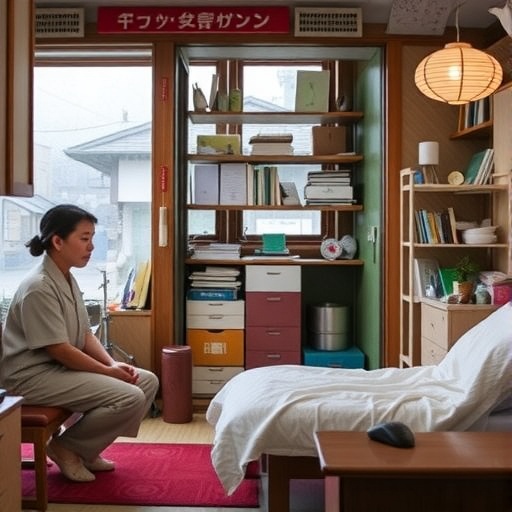In recent years, Japan has garnered attention for its unique healthcare system, renowned for its comprehensive coverage and focus on quality of care. However, emerging evidence indicates significant disparities in the utilization of home-based medical care across various regions of the country. This disparity warrants critical examination, particularly as the population ages and the need for accessible healthcare becomes increasingly paramount. A new study by Shibata and Kaneko delves into these regional inequalities, utilizing extensive nationwide claim data to shed light on the factors influencing home-based medical care utilization in Japan.
The concept of home-based medical care holds significant importance in the context of Japan’s healthcare framework. As a nation with one of the highest life expectancies globally, Japan faces the challenge of meeting the healthcare needs of an increasingly elderly population. Home-based medical care offers a viable solution, enabling patients to receive necessary medical attention within the comfort of their own homes. Such an approach not only enhances patient convenience but also alleviates the burden on hospitals and healthcare facilities, aligning with Japan’s goals of maintaining an efficient healthcare system amidst demographic shifts.
Shibata and Kaneko’s ecological study is a thorough analysis of nationwide claim data, meticulously dissecting the patterns of home-based medical care utilization across Japan’s diverse regions. The researchers have carefully selected numerous variables, including socioeconomic factors, demographic profiles, and healthcare infrastructure, to paint a comprehensive picture of the services provided. Their findings reveal stark contrasts between urban and rural areas, a trend that may impact overall healthcare policy and allocation of resources.
The implications of regional disparities cannot be overstated. In densely populated urban centers, home-based medical care services are often more readily accessible, with an array of healthcare providers offering extensive support. Conversely, rural regions may lack the necessary healthcare infrastructure and personnel, resulting in a pronounced gap in service provision. This inequity highlights the need for tailored healthcare strategies that specifically address the unique challenges faced by rural communities.
Moreover, the study reveals the influence of socioeconomic status on the accessibility and utilization of home-based medical care. Regions with higher income levels are generally associated with better healthcare outcomes, potentially due to improved access to medical services and the availability of advanced healthcare technologies. On the other hand, economically disadvantaged areas may experience higher barriers to accessing essential medical care, further exacerbating disparities between different demographics.
In addition to socioeconomic factors, the authors explore the role of cultural attitudes towards home-based medical care. In Japan, traditional views surrounding health and illness can significantly shape how individuals perceive and engage with healthcare services. Such cultural perspectives may either encourage or deter patients from seeking home-based care, contributing to the variances identified in the study. By understanding these cultural influences, policymakers can better develop initiatives that resonate with local populations, promoting greater utilization of home-based medical services.
The research conducted by Shibata and Kaneko does not merely highlight disparities; it offers potential pathways for improvement. By identifying the regions most affected by inequities, stakeholders can prioritize targeted interventions to enhance healthcare accessibility. This may involve deploying more healthcare professionals to underserved areas, investing in infrastructure improvements, or implementing community-based education programs aimed at raising awareness about available services.
Furthermore, the study underscores the critical need for ongoing data collection and analysis to monitor trends and changes in home-based medical care utilization over time. As the landscape of healthcare continues to evolve, maintaining up-to-date information is essential for informing effective policy decisions and ensuring that the healthcare system remains responsive to the needs of the population.
As Japan navigates the challenges posed by its aging society, understanding the nuances of healthcare utilization will be crucial. Regional disparities in home-based medical care usage encapsulate a broader issue within the healthcare system—one that requires concerted efforts across multiple sectors to address effectively. By equipping healthcare providers with the necessary resources and support, Japan can move towards a more equitable healthcare landscape that prioritizes the needs of all citizens.
In conclusion, the study by Shibata and Kaneko is a timely reminder of the complexities inherent in delivering healthcare to an aging population. The disparities in home-based medical care utilization reveal systemic issues that, if left unchecked, could lead to significant inequalities in health outcomes across Japan. As health professionals, policymakers, and communities work collectively to bridge these gaps, the findings from this study will undoubtedly serve as a valuable resource in the pursuit of equitable healthcare for all.
The multifaceted nature of regional disparities necessitates a deeper understanding of the intricate interplay between various factors influencing healthcare access. Addressing these disparities will not only enhance the quality of care available to those in need but also promote a more sustainable and effective healthcare system in the long run. The findings of this research may also serve as a model for other nations grappling with similar challenges, illustrating the importance of data-driven approaches in crafting effective health policies.
Through continued research and dialogue, there remains hope for a healthcare future where all individuals, regardless of their regional or socioeconomic status, can enjoy the benefits of comprehensive and accessible medical care. As Japan progresses on this journey, the insights provided by Shibata and Kaneko’s study may prove invaluable in shaping the next chapter of its healthcare narrative.
Subject of Research: Regional Disparities in Home-Based Medical Care Utilization in Japan
Article Title: Regional Disparities in Home-Based Medical Care Utilization in Japan: Ecological Study of Nationwide Claim Data
Article References:
Shibata, M., Kaneko, M. Regional Disparities in Home-Based Medical Care Utilization in Japan: Ecological Study of Nationwide Claim Data. J GEN INTERN MED (2025). https://doi.org/10.1007/s11606-025-09945-1
Image Credits: AI Generated
DOI:
Keywords: Home-based medical care, regional disparities, Japan, healthcare accessibility, socioeconomic status, elderly care.
Tags: aging population healthcare needsdemographic shifts in Japanese healthcareelderly patient care in Japanhealthcare accessibility challenges Japanhealthcare efficiency in Japanhealthcare system analysis Japanhome-based healthcare solutions JapanJapan home medical care utilizationnationwide claim data study Japanpatient convenience home careregional disparities in healthcare JapanShibata and Kaneko research






